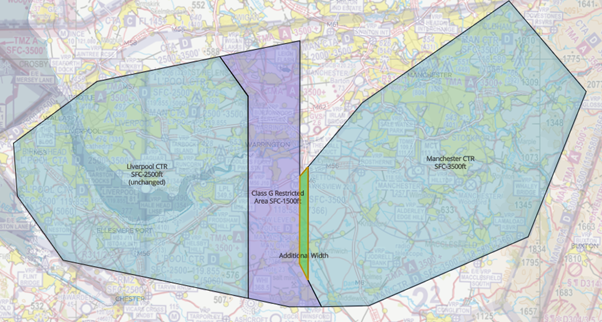At a glance
- UK’s aviation regulator approves changes to the Manchester Low-Level Route (MLLR).
- The MLLR will be replaced by the North West Transit Corridor, and reclassified as Class G airspace with specific restrictions starting 20 February 2025.
- Change will enhance safety and efficiency by simplifying the airspace structure, mitigate collision risks, and enable smoother navigation between Manchester and Liverpool Airports for general aviation pilots.
The UK Civil Aviation Authority has approved an amendment to the airspace currently known as the Manchester Low-Level Route (MLLR). The MLLR will be reclassified and replaced by a Class G airspace Restricted Area to be known as EGR323 North West Transit Corridor.

The new North West Transit Corridor will continue to provide crucial north-south routing for aircraft, enabling them to navigate efficiently between Manchester and Liverpool Airports’ adjoining Class D airspaces.
The changes, which aim to reduce the risk of mid-air collisions and improve airspace management, will take effect from 20 February 2025. This coincides with the expiration of the current exemption in this airspace, Official Record Series 4 (ORS4) No.1596.
Jon Round, Head of Airspace, Air Traffic Management, and Aerodromes at the UK Civil Aviation Authority said:
“This is a significant step in enhancing both safety and accessibility for airspace users in the North West.
By simplifying the structure of this critical corridor and reducing the risk of mid-air collisions, we’re ensuring that pilots can continue to benefit from efficient transit between Manchester and Liverpool Airports without compromising on safety.
This amendment is part of our ongoing commitment to modernising the UK’s airspace and improving air traffic management for everyone.”
The amendment includes:
- Reclassifying the current Class D MLLR airspace to Class G uncontrolled airspace.
- Implementing a Restricted Area within the reclassified airspace that will limit the speed and weight of the aircraft, as well as having visibility and QNH setting restrictions.
- A maximum altitude within the Class G airspace of 1500ft – 200ft higher than the previous MLLR permitted.
- Creating Class G airspace 0.65 nautical miles wider to the east than today’s MLLR boundary.
The regulator’s decision to reclassify this portion of airspace follows input from the general aviation community, air navigation service providers, and local airports as part of its function to review airspace classification.
Notes to editors:
- For further inquiries, members of the public should contact airspace.classification@caa.co.uk.
- This amendment was developed by the UK Civil Aviation Authority and relates to airspace provided for smaller general aviation aircraft. It is a wholly separate piece of work to the airspace change proposals being prepared by both Manchester and Liverpool Airports, as part of the FASI program. This amendment does not affect commercial aviation traffic into or out of either of these airfields.
News from UK Civil Aviation Authority
- Experts appointed by regulator to strengthen economic regulation and support growth
- UK Civil Aviation Authority and Ministry of Defence join forces to build pathway into civil aviation for military personnel
- Regulator’s accessibility assistance report highlights progress made by most UK airports but finds three airports need improvement

